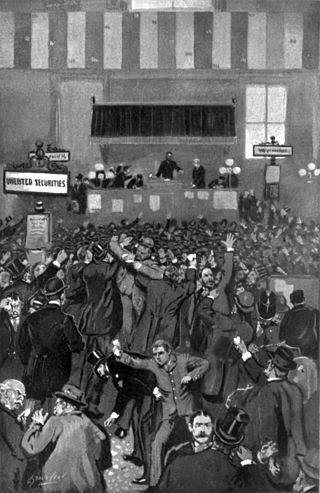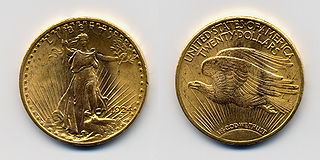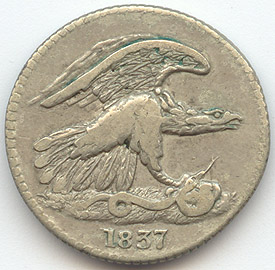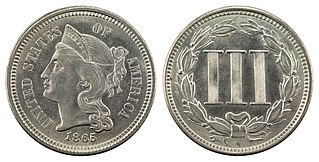
Martin Van Buren was the eighth president of the United States, serving from 1837 to 1841. A primary founder of the Democratic Party, he served as New York's attorney general and U.S. senator, then briefly as the ninth governor of New York before joining Andrew Jackson's administration as the tenth United States secretary of state, minister to Great Britain, and ultimately the eighth vice president from 1833 to 1837, after being elected on Jackson's ticket in 1832. Van Buren won the presidency in 1836 against divided Whig opponents. Van Buren lost re-election in 1840, and failed to win the Democratic nomination in 1844. Later in his life, Van Buren emerged as an elder statesman and an anti-slavery leader who led the Free Soil Party ticket in the 1848 presidential election.
The Specie Circular is a United States presidential executive order issued by President Andrew Jackson in 1836 pursuant to the Coinage Act of 1834. It required payment for government land to be in gold and silver (specie).

The Panic of 1893 was an economic depression in the United States. It began in February 1893 and officially ended eight months later, but the effects from it continued to be felt until 1897. It was the most serious economic depression in history until the Great Depression of the 1930s. The Panic of 1893 deeply affected every sector of the economy and produced political upheaval that led to the political realignment and the presidency of William McKinley.

The Panic of 1837 was a financial crisis in the United States that began a major depression which lasted until the mid-1840s. Profits, prices, and wages dropped, westward expansion was stalled, unemployment rose, and pessimism abounded.

Exonumia are numismatic items other than coins and paper money. This includes "Good For" tokens, badges, counterstamped coins, elongated coins, encased coins, souvenir medallions, tags, wooden nickels and other similar items. It is an aspect of numismatics and many coin collectors are also exonumists.

Hard money policies support a specie standard, usually gold or silver, typically implemented with representative money.
Pet banks is a derogatory term for state banks selected by the U.S. Department of Treasury to receive surplus Treasury funds in 1833. Pet banks are sometimes confused with wildcat banks. Although the two are distinct types of institutions that arose concomitantly, some pet banks were known to also engage in practices of wildcat banking. They were chosen among the big U.S. banks when President Andrew Jackson vetoed the recharter for the Second Bank of the United States, proposed by Henry Clay four years before the recharter was due. Clay intended to use the rechartering of the bank as a topic in the upcoming election of 1832. The charter for the Second Bank of the United States, which was headed by Nicholas Biddle, was for a period of twenty years beginning in 1816, but Jackson's distrust of the national banking system led to Biddle's proposal to recharter early, and the beginning of the Bank War. Jackson cited four reasons for vetoing the recharter, each degrading the Second Bank of the United States in claims of it holding an exorbitant amount of power. These reasons for vetoing the recharter were centered around Jackson's belief in his role as the representative of the common man. Amos Kendall, who was the intellectual driving force behind Jackson's 1832 election and Jackson himself, led Jackson to believe that the bank posed a political threat to Jackson. Kendall cautioned Jackson that unless he got rid of the Second Bank of the United States, it would find a way to elect its own candidate to the White House after Jackson was gone. Jackson saw the bank as a threat to the common man and "the great enemy of republicanism", and argued that as long as the national bank existed, the working class was constantly in danger of losing their stake in government.

The Indian Head cent, also known as an Indian Head penny, was a one-cent coin ($0.01) produced by the United States Bureau of the Mint from 1859 to 1909. It was designed by James Barton Longacre, the Chief Engraver at the Philadelphia Mint.
The Independent Treasury was the system for managing the money supply of the United States federal government through the U.S. Treasury and its sub-treasuries, independently of the national banking and financial systems. It was created on August 6, 1846, by the 29th Congress, with the enactment of the Independent Treasury Act of 1846. It was expanded with the creation of the national banking system in 1863. It functioned until the early 20th century, when the Federal Reserve System replaced it. During this time, the Treasury took over an ever-larger number of functions of a central bank and the U.S. Treasury Department came to be the major force in the U.S. money market.

In numismatics, token coins or trade tokens are coin-like objects used instead of coins. The field of token coins is part of exonumia and token coins are token money. Their denomination is shown or implied by size, color or shape. They are often made of cheaper metals like copper, pewter, aluminium, brass and tin, or non-metals like bakelite, leather and porcelain.

The Bank War was a political struggle that developed over the issue of rechartering the Second Bank of the United States (B.U.S.) during the presidency of Andrew Jackson (1829–1837). The affair resulted in the shutdown of the Bank and its replacement by state banks.

The Feuchtwanger cent was a nickel silver private token coin circulated in the U.S. by Lewis Feuchtwanger during the 1830s and 1840s. Three-cent varieties were also available, though not as plentiful as the one-cent tokens.
The Panic of 1796–1797 was a series of downturns in credit markets in both Great Britain and the newly established United States in 1796 that led to broader commercial downturns. In the United States, problems first emerged when a land speculation bubble burst in 1796. The crisis deepened when the Bank of England suspended specie payments on February 25, 1797 under the Bank Restriction Act of 1797. The Bank's directors feared insolvency when English account holders, who were nervous about a possible French invasion, began withdrawing their deposits in sterling rather than bank notes. In combination with the unfolding collapse of the U.S. real estate market's speculative bubble, the Bank of England's action had deflationary repercussions in the financial and commercial markets of the coastal United States and the Caribbean at the start of the 19th century.

The presidency of Andrew Jackson began on March 4, 1829, when Andrew Jackson was inaugurated as 7th President of the United States, and ended on March 4, 1837. Jackson took office after defeating incumbent President John Quincy Adams in the bitterly contested 1828 presidential election. During the 1828 presidential campaign, Jackson founded the political force that coalesced into the Democratic Party during Jackson's presidency. Jackson won re-election in 1832, defeating National Republican candidate Henry Clay by a wide margin. He was succeeded by his hand-picked successor, Vice President Martin Van Buren, after Van Buren won the 1836 presidential election.

The presidency of Martin Van Buren began on March 4, 1837, when Martin Van Buren was inaugurated as 8th President of the United States, and ended on March 4, 1841. Van Buren, the incumbent vice president and chosen successor of President Andrew Jackson, took office after defeating multiple Whig Party candidates in the 1836 presidential election. A member of the Democratic Party, Van Buren's presidency ended following his defeat by Whig candidate William Henry Harrison in the 1840 presidential election.
The Coinage Act of 1857 was an act of the United States Congress which ended the status of foreign coins as legal tender, repealing all acts "authorizing the currency of foreign gold or silver coins". Specific coins would be exchanged at the Treasury and re-coined. The act is divided into seven sections.

The copper-nickel three-cent piece, often called a three-cent nickel piece or three-cent nickel, was designed by US Mint Chief Engraver James B. Longacre and struck by the United States Bureau of the Mint from 1865 to 1889. It was initially popular, but its place in commerce was supplanted by the five-cent piece, or nickel.
The Second Bank of the United States opened in January 1817, six years after the First Bank of the United States lost its charter. The Second Bank of the United States was headquartered in Carpenter's Hall, Philadelphia, the same as the First Bank, and had branches throughout the nation. The Second Bank was chartered by many of the same congressmen who in 1811 had refused to renew the charter of the original Bank of the United States. The predominant reason that the Second Bank of the United States was chartered was that in the War of 1812, the U.S. experienced severe inflation and had difficulty in financing military operations. Subsequently, the credit and borrowing status of the United States was at its lowest level since its founding.

Bryan Money is a term used by numismatists to refer to tokens and medals associated with William Jennings Bryan's platform during the United States presidential elections of 1896 and 1900. Bryan's platform advocated for the reinstatement of silver currency in the United States economy as part of the short-lived Silver Republican Party.

The two-cent billon was a pattern US coin struck in 1836 and initially proposed as part of the Act of January 13, 1837. Versions exist with either a reeded edge and coin orientation or a plain edge and medal orientation; however, those with the former tend to be original strikes, whereas the latter are always proof restrikes.
















